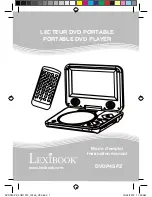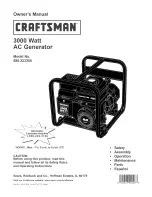
12
NOTE:
Dielectric grease should be used on battery posts
to aid in the prevention of corrosion.
NOTE:
Damage will result if battery connections are made
in reverse.
NOTE:
In areas where temperatures regularly fall below
10° F (-12° C) it is recommended that a pad type
battery heater be installed to aid in cold climate
starting.
1.14 THE BATTERY
DANGER
Do not dispose of the battery in a fire. The
battery is capable of exploding.
A battery presents a risk of electrical shock
and high short circuit current. The following pre-
cautions are to be observed when working on
batteries:
• Remove the 7.5A fuse from the generator control
panel.
• Remove watches, rings or other metal objects;
• Use tools with insulated handles;
• Wear rubber gloves and boots;
• Do not lay tools or metal parts on top of the
battery; and
• Disconnect charging source prior to connecting or
disconnecting battery terminals.
Do not open or mutilate the battery. Released
electrolyte has been known to be harmful to the
skin and eyes, and to be toxic.
The electrolyte is a dilute sulfuric acid that is
harmful to the skin and eyes. It is electrically
conductive and corrosive.
The following procedures are to be observed:
• Wear full eye protection and protective clothing;
• Where electrolyte contacts the skin, wash it off
immediately with water;
• Where electrolyte contacts the eyes, flush thor-
oughly and immediately with water and seek
medical attention; and
• Spilled electrolyte is to be washed down with an
acid neutralizing agent. A common practice is to
use a solution of 1 pound (500 grams) bicarbonate
of soda to 1 gallon (4 liters) of water. The bicar-
bonate of soda solution is to be added until the
evidence of reaction (foaming) has ceased. The
resulting liquid is to be flushed with water and the
area dried.
Lead-acid batteries present a risk of fire because
they generate hydrogen gas. The following
procedures are to be followed:
• DO NOT SMOKE when near the battery;
• DO NOT cause flame or spark in battery area; and
• Discharge static electricity from body before touch-
ing the battery by first touching a grounded metal
surface.
Be sure the AUTO/OFF/MANUAL switch is set to
the OFF position before connecting the battery
cables. If the switch is set to AUTO or MANUAL,
the generator can crank and start as soon as the
battery cables are connected.
Be sure the utility power supply is turned off
and the 7.5A fuse is removed from the genera-
tor control panel, or sparking may occur at the
battery posts as the cables are attached and
cause an explosion.
Servicing of the battery is to be performed or super-
vised by personnel knowledgeable of batteries and
the required precautions. Keep unauthorized person-
nel away from batteries.
See the Specifications section for the correct size
and rating when replacing the battery. Have these
procedures performed at the intervals specified in
the “Service Schedule.” A negative ground system is
used. Battery connections are shown on the wiring
diagrams. Make sure the battery is correctly connect-
ed and terminals are tight. Observe battery polarity
when connecting the battery to the generator set.
1.15 BATTERY CHARGER
NOTE:
These generators DO NOT contain an internal bat-
tery charger.
NOTE:
The manufacturer provides a battery trickle char-
ger that is active when the unit is set up for auto-
matic operation. With the battery installed and
utility power source voltage available to the trans-
fer switch, the battery receives a trickle charge
to prevent self-discharge. The trickle charger is
designed to help extend the life of the battery by
maintaining the battery. The trickle charge feature
cannot be used to recharge a discharged battery.
For units shipped with a transfer switch/load center,
the battery charger is pre-installed in the transfer
switch enclosure.
For units shipped without a transfer switch/load cen-
ter, a separate battery charger module is included
with the generator.
(For battery charger installation, see the Generator
Install Guidelines and Battery Charger Instructions
included with the unit.)
Section 1 — General Information
Air-cooled Generators
Summary of Contents for 8kW
Page 1: ...Study Guide S e r v i c e T r a i n i n g Air Cooled Training...
Page 2: ......
Page 36: ...32 32 Section 7 Notes Air cooled Generators...
Page 37: ...33 Section 8 Installation Diagrams Air cooled Generators Circuit Breakers Drawing No 0G8573 A...
Page 38: ...34 Section 8 Installation Diagrams Air cooled Generators Generator Drawing No 0G8280 D...
Page 39: ...35 Section 8 Installation Diagrams Air cooled Generators Generator Drawing No 0G8280 D...
Page 42: ...Part No 0G8334 Revision D 09 16 08 Printed in U S A Catalog No OMASPCA S 01...
Page 58: ...14 Section 5 Electrical Data RTSS Type Transfer Switch Wiring Diagram Drawing No 0G7817 B...
Page 59: ...15 Section 5 Electrical Data RTSS Type Transfer Switch Wiring Diagram Drawing No 0G7817 B...
Page 64: ...20 Section 7 Notes...
Page 65: ...21 Section 7 Notes...
Page 66: ...Part No 0G8637 Revision D 08 27 08 Catalog No KGALT 1SI Printed in U S A...
Page 68: ......
Page 76: ...8 Residential Transfer Switch Installation Guide Installation Drawing 0H0258 A...
Page 77: ...9 Residential Transfer Switch Installation Guide Installation Drawing 0H0258 A...
Page 78: ...Residential Transfer Switch Installation Guide Installation Drawing 0G8573 A 10 10...
Page 79: ...11 Residential Transfer Switch Installation Guide Electrical Schematic Drawing 0G7959 A...
Page 80: ...12 Residential Transfer Switch Installation Guide Wiring Diagram Drawing 0G7958 A...
Page 81: ...13 Residential Transfer Switch Installation Guide Wiring Diagram Drawing 0G7958 A...
Page 82: ...14 Residential Transfer Switch Installation Guide Load Center Exploded View Drawing 0G8786 C...
Page 84: ...16 Residential Transfer Switch Installation Guide Notes...
Page 85: ...17 Residential Transfer Switch Installation Guide Notes...
Page 86: ...Part No 0G8571 Revision D 07 31 08 Catalog No KGATX100 1SI Printed in U S A...
Page 91: ...5 REFERENCE Items supplied in the EZ Transfer operator kit...
Page 92: ...6...
Page 93: ...7...
Page 95: ...Air cooled Generator Battery Charger Installation Guidelines...
Page 113: ...17 Section 6 Notes Battery Charger Installation Guidelines...
Page 114: ...Part No 0G7956 Revision B 11 14 08 Printed in U S A...
Page 115: ......
















































